Hello fans of all things strings, I hope you are all playing and learning and most of all enjoying your guitar experiences. The marriage of the electric guitar and electric bass has always been an integral part of the fabric that is rock and roll. I believe that the model and subsequent sound of the bass of choice for a group is actually more important then the guitar and its sound. Case in point could you picture James Jameson playing an Alembic bass, or Chris Squire playing an EB0? Me neither. So lets get into this, and I will give you my opinion on in what I believe to be THE 10 MOST IMPORTANT BASSES IN ROCK & ROLL HISTORY!!!
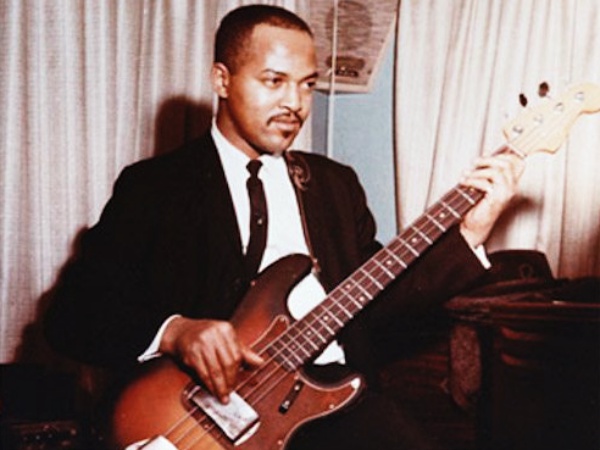
James Jameson and his P-bass helped to define the Motown sound.
1. Fender Precision Bass
This is the bass that started it all. And all through its many incarnations the P-Bass is, and will always be the industry standard and the safe choice for any application. The bass was so damn popular that you would see ads that read “Band Looking for Fender Bass Player”. It was a distinction that grew out of a way for band leaders to let the bass player know that he could leave his upright at home. It also denoted a preconceived style of music that the bandleader or producer wanted. The “Precision’’ had one pickup and basically one sound, but that sound kicked ass! If you want to hear a few of the P-Basses signature sounds check out James Jamerson’s Motown recordings, and the edgy Precision bass sound on Joe Cocker live at Woodstock’s “With a Little Help from Me Friends.” Even in today’s world of 5, 6 and 7 string basses the P Bass makes a statement when it is produced at a gig or an audition. It says “I understand and respect the roots of bass playing.”If you’re a bass player of any serious stature and you don’t have a Precision Bass, then you better have a Jazz Bass.

1964 Rickenbacker 4001S Bass Guitar
2. Rickenbacker 4001 Bass
Rickenbacker instruments have been paired with Vox amps over the years, evidenced by the Beatles, Tom Petty (Mike Campbell), and REM to name a few. Interestingly I believe that Ricks are to Fender and Gibson guitars what Vox is to Marshall and Fender amplifiers. Okay point made, now onto the 4001. The first time I saw the Rick 4001 was on the cover of Magical Mystery Tour. There it was, right next to George holding an early rosewood Strat. I listened closely to the record that was included with the cover and could hear a discernable difference in tone from Paul’s previous bass sound. Actually it wasn’t that different because again Paul’s Rick was strung with flatwound bass strings. But unlike the Hofner bass the Rickenbacker’s fate did not lie solely in the hands of the man from Liverpool. Chris Squire armed with a Ricky and some roundwound Rotosounds quickly became the captain of the good ship 4001. His playing on Fragile is mindblowing, and I know it is safe to say that his playing influenced players like Stanley Clarke and Jaco Pastorious, as well as a generation of checkerboard wielding Rickophiles. Again the bass was equipped with two single coils and a very cool pickup cover over the back pickup reminiscent of the old Rickenbacker “Frying Pan” lap steel. Even the great Lemmy from Motorhead played a 4001, adding another sound to the palette offered by the great bass from Cali.

1977 Fender Jazz Bass Guitar
3. Fender Jazz Bass
Leo sure must have loved jazz and as any of us in the guitar business know, you ain’t gonna make a million dollars selling instruments made for jazz. But, Leo’s second offering in the world of basses was sure a home run. Unlike his Jazzmaster which was as unjazzy an instrument as you can possibly imagine, the Jazz Bass actually sounded great playing jazz. Legendary jazz player Ron carter played a JB with great style and dignity, but it was Jaco Pastorius that brought the Jazz Bass to another level. Jaco utilizing the back pickup on his defretted JB created a lyrical smooth sound that was truly magical. Years later another bass master the great Marcus Miller played the Jazz Bass with great distinction. Rock players as well enjoy the J Bass, like Geddy Lee, Dave Brown (Santana) and John Paul Jones.
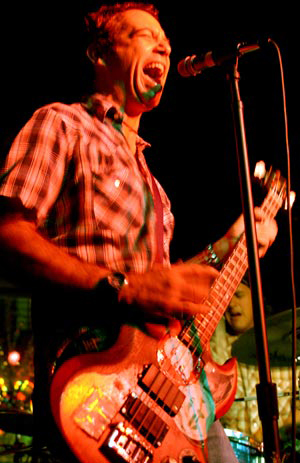
Mike Watt with his 1963 Gibson EB3 Bass Guitar
4. Gibson EB3 Bass
The bass that Jack Bruce played, and played so well, was an also ran in the bass race of the rock and roll era. I personally believe that the EB3 was destined to die a fiery death if not for the great Jack. In reality the EB3 was a victim of the amplifiers of the era. The high output of the massive neck humbuckers over drove the preamp section of most of the era’s Neanderthal bass rigs. It never sounded clean, but it was Jack Bruce that went with it, and played with the back pickup, which is a smaller mini humbuckers design. This growl became Jack’s signature sound. Any of you who want to hear Jack and his EB3 at their best you must go out and get his first solo album after Cream called “Songs for a Tailor”
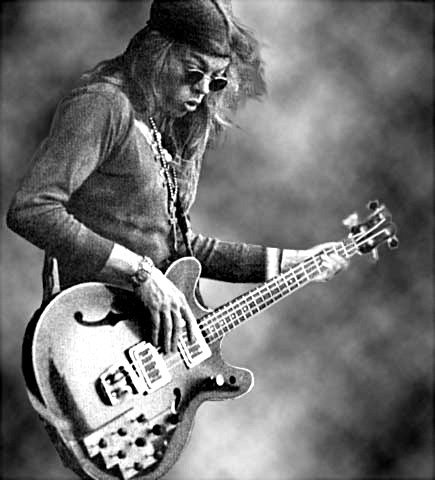
Jack Casady with his Guild Starfire Bass Guitar
5. Guild Starfire Bass
Often copied but never improved upon, the semi-hollow Starfire bass was to my ears the best sounding semi of them all. Guild instruments are and always will be underrated and a best buy for the buck. This bass, made famous by Jack Casady of the Jefferson Airplane had two versions, the first produced from 1965 to 1969 sported a single coil pickup, and the latter featured humbucking pickups. The one Jack used was the single coil version, and it sounded chunky and percussive. I am sure Jack’s technique had something to do with it, but it was an awesome sound. This is one bass that begs for round wound strings, to enhance the bite of the single coils. The Gibson EB1 was a muddy version of the Starfire basses.
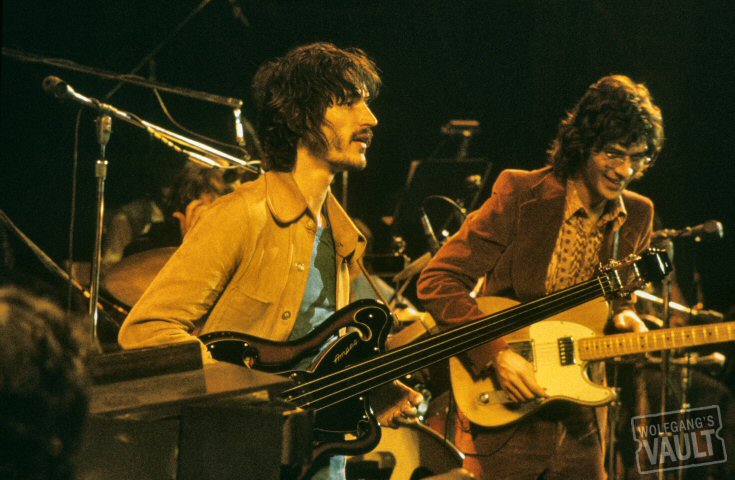
Ricky Danko and his Ampeg AUB-1 bass
6. Ampeg AUB-1 Bass
There can be little doubt that the Ampeg AUB-1 is one of the most unique fretless basses ever made, with its offset body and cut-thru f-hole. A striking look, for sure, but it also sounds amazing. This model (and the fretted version, the AEB-1) are very rare and hard to find now – only around 1150 AEB-1 and AUB-1 basses were manufactured between 1966-1968. But thanks to being used by artists such as Ricky Danko (watch “The Weight” from The Last Waltz film) it has become the stuff of legend. The AEB-1 was also used by Adam Yauch in the Beastie Boys. Thankfully, the Eastwood tribute models are fantastic alternatives if you can’t afford an original. Both the Eastwood EUB-1 fretless and EEB-1 are still available and well worth checking out:

Eastwood EUB-1 | ORDER NOW, Only $898 USD
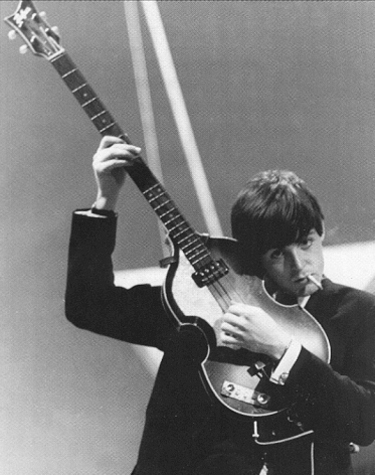
Paul McCartney with his 1963 Hofner Model 500/1 Bass Guitar
7. Hofner Model 500/1 Beatle Bass
Paul McCartney, Paul McCartney, Paul McCartney. What the hell was this guy doin’? What was he playing through? What kinda strings was he using? Now I think Paul would have sounded great if he was playing a cigar box strung up with rubber bands played through a transistor radio but that’s my hang up. Paul was the man, and that little bass sounded great in his capable hands. The 500/1 premiered in 1956 and it featured a set of mini humbuckers and a spruce top. That combination would usually spell disaster especially at higher volumes, but it didn’t. And by the way I’ll finish like I started, all you aspiring Paulie Mac’s use flatwounds, use flatwounds, use flatwounds.
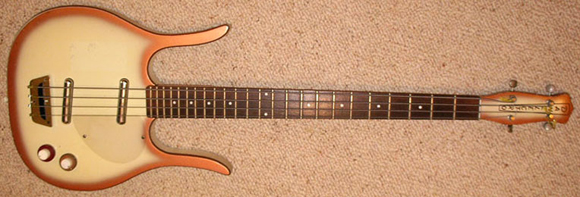
1959 Danelectro Longhorn Bass Guitar
8. Danelectro Longhorn Bass
No matter how cheap you think this bass was, it was a killer sounding low frequency machine for sure. Those anemic “lipstick” bass pickups sounded so good, whether coming through an amp (preferably a big one) or through the console in a recording studio. Legend has it that the bass part for “Take a Walk on the Wild Side” was recorded with a Longhorn by 60’s electronic wiz Dan Armstrong. (his son Kent told me). The Danny was light weight, and as sexy looking as Phoebe Cates getting out of the pool in “Fast Times at Ridgemont High”. And great news is that the reissue ones sound as good as the originals.
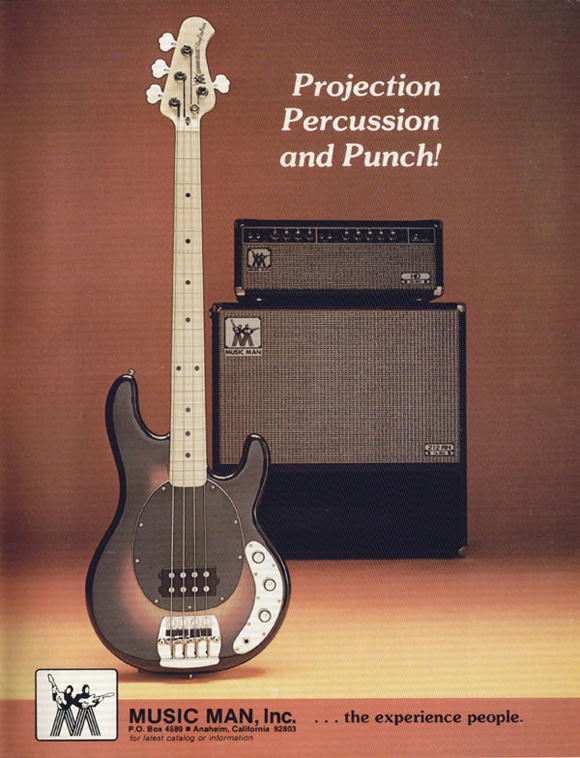
1977 Music Man Stingray Bass Guitar
9. Music Man Sting Ray Bass
Well Leo you did it again! This bass was the first mass produced active electronic bass. It was made available in the summer of 1976, to rave reviews. The massive pickup produced a sound never heard before, and the pole pieces were the size of a dime. The Sting Ray had a volume control and a bass and treble control as well. This way you could add or cut bass and treble separately, way snappy. You could for the first time get a sound that wasn’t a Fender or Gibson sound. This bass became synonymous with cats like Bernard Edwards of Chic and Tony Levin (of everybody).
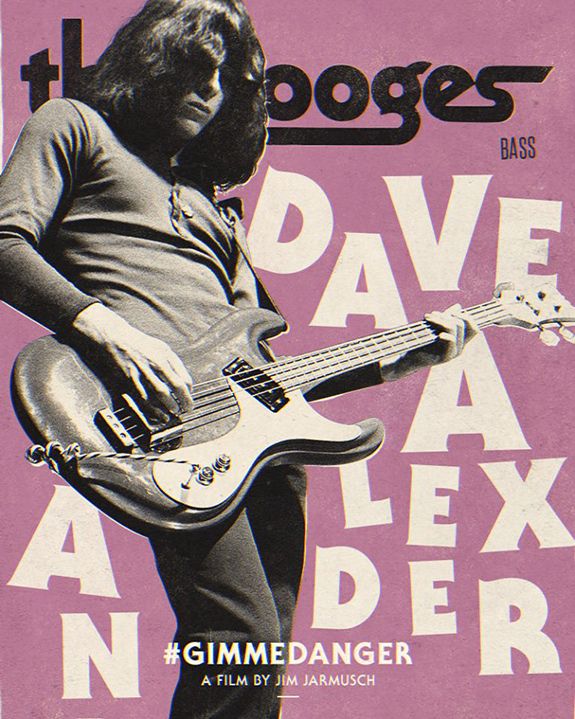
Dave Alexander and his Mosrite bass
10. Mosrite Ventures Bass
Of course, Mosrite was not just about the guitar! The Ventures bass was famously used by, obviously, the Ventures, but it also put its mark in the dirtiest corners of rock’n’roll thanks to being used by John Entwistle in The Who and, especially, Dave Alexander in The Stooges. Available with one or two pickups, the Mosrite Bass is one of the few models ever made featuring hot, P90-style pickups – rocking! Once again, Eastwood paid tribute to Mosrite, and their Sidejack 32 bass is the ideal choice for punk rockers, fans of Dave Alexander or anyone looking for a bass with extra kick.

I agree with most but… I’d change the 10th place (Black Widow) for an Alembic Series I or II. That was yet another revolution in the world of bass. It made a huge impact on how modern basses are made today and it’s is still a class on its own. Yes, Fender basses are still the thing to go to when you’re looking for a genuine rock sound (I have a Geddy Lee Jazz myself and I love it) but the Wickershams created a truly different (and beautiful) beast for those for those who were looking for new sounds and looks. My favourite of my 3 basses is the Alembic Essence 5 – it’s my main weapon and I intend to keep it forever.
BTW – I took a liberty to borrow the picture of the Steinberger to put it on my list of Top 10 most significant 80s basses on my blog: http://bass-driver.blogspot.com/2012/11/top-10-ejtisy.html (it’s in Polish – if you want a rough translation I can do that for you). If you have a problem with it let me know – I’ll find something else 🙂
You say “Legend has it that the bass part for “Take a Walk on the Wild Side” was recorded with a Longhorn by 60’s electronic wiz Dan Armstrong.” I think you’ll find it was Herbie Flowers who played (and wrote) that line.
The list is pretty much OK though.
Your list is pretty much complete.The only thing I would add is my 1987 Jackson Charvel (Japanese made). I’ts the best bass I’ve ever had in 50 years of playing music.I also picked up a “Shredder” bass at a second hand store in Hannibal,Missouri.I believe the manufacture date was 1982.I’ts a three-quarter scale neck,solid white with one volume and one tone control.If you have any info. on this bass,please let me know I tried Gibson,s website,but had no luck.Thanks for your website.BASS PLAYERS RULE!
The list is a good one, but the Danelectro/Sears single-cutaway “Short Horn” belongs on it, too. In the 1960s and early 1970s, if you couldn’t afford a Fender, a lot of folks opted for cheap Danelectro basses sold as Silvertones by Sears. They sounded better than the Gibsons (and the Kays and the Harmonys and the cheap Japanese basses of the time) and anyone could afford one. With their short necks and flatwound strings, they played ridiculously easy and sounded much better than they should have.
I think the Ibanez 5-string bass should be on this list, or at-least whatever the first popular 5-string was. In the late ’90s, I thought the 5-string bass was on its way to replacing the standard 4-string, especially in heavy metal. Fieldy of Korn fame not only popularized it (as his bandmates did with 7-strings) but popularized a slapping technique rooted–whether he realized it or not–in Bill Black’s bass playing in Elvis’ early records.
I’d also hoped to maybe see fretless basses and/or 8-string basses. I believe the later became popular in bands with a bass player, a lead guitarist but no rhythm guitarist, like Mötley Crüe because it can allow the bass to double for a rhythm guitar in certain riffs.
That’s just me. It’s still a pretty good list.
Hofner 500/1 ‘ Beatle ” Bass and Danelectro Longhorn should be in the top 5 .
Hofner 500/1 , Dano Longhorn , Jazz , p-bass and Ric should be in the top 5 .
The Guild , Steinberger and EB3 had a lot less impact and use than the Hofner and the Dano.
Check out a list of people that have played Beatle basses. Danos would have been the first bass of a lot of stars and session players .
You nailed most of the influential basses, not quite sure what that Black Widow is doing there. My first and workhorse for most of the 30 plus years I played professionally was the Gibson EBO, which morphed to an EB3, then I added Shaller tuners, had a custom parametric eq preamp installed, replaced the neck pup with a Guild, (even more power), and later replaced the bridge with a Wilkerson. I owned a Fender Precision but my hands never felt comfortable with that neck.
In 78, I bought the new MusicMan Sabre Bass, and played that for many years,
only recently regrettably parting with it. Then fulfilled the wish for a Hofner, but, at the last moment of purchase, switched and bought the Hofner Club Bass instead of
the Beatle Bass, because frankly everybody other than McCartney looks foolish playing it. You might as well slap a cheap Beatle wig on while you’re at it.
Now, I have my sights set on a new Jazz Bass! Before I fell for the EBO, I had looked at the Rickenbacher, which I love that tone, but, again the neck and weight nixed it.
Ampeg / Dan Armstrong Lucite Bass…..Enough said.
I read a lot of interesting content here. Probably you spend a
lot of time writing, i know how to save you a lot of work, there
is an online tool that creates unique, SEO friendly articles
in seconds, just search in google – laranitas free content source
Gibson Thunderbird would be my choice, feels & sounds like no other
One word…Thunderbird!
Growing up in the 80s, I can tell you the Steinberger XL-2 was the Fender Precision of new wave and 80s funky/R&B pop and therefore its relevance cannot be underestimated.
It made graphite a go-to material ever since. It was re-vo-lu-tio-na-ry. BTW Ned’s Spector bass could have been #10 on list.
Geddy Lee played the XL-2. Elton John’s bassist played it. Kool of Kool and The Gang played it. Gary Beers of INXS… Ben Orr of The Cars… Danny Klein of J. Geils Band… Kasim Sulton of Utopia and countless sessions… it was everywhere. It has a great unique loud and crisp tone.
Hi Ola,You probably haered this a couple of times before but your tutorials are AWESOME! I’m playing guitar for about 8 years now but I’m kinda new to that recording thing and your tutorials have really helped me alot!When I first saw your amp-testing videos I honestly thought they were fake Don’t get me wrong, this is absolutely no offence but your sound was just TOO f***ing good to be true so I’m really glad you made these tutorials to show noobs like me how you do itJust wanted to thank you for that Greetings from CroatiaDenis
Don’t forget – Geddy Lee started with a Ric.
Hard to understand how the Black Widow is an important rock & roll bass when there are so few of them made and they are not associated with any major rock players. (Doc Watson is not rock & roll). The modest Harmony H22 had more players of note in the 1960s.
My top 10 in order of period influence
1. Precision Bass (50’s)
2. Hofner
3. Jazz Bass
4. Rickenbacker 4001
5. Gibson EB3
6. Gibson Thunderbird
7. Guild Starfire
8. Alembic
9. Musicman Stingray
10. Steinberger
All these basses were played by pro bassists and were made famous because of it.
Agreed on this list for the most part with exception of the Dan electro shouldn’t even be on the radar. The Alembic should be in its place. The Acoustic? ? Never heard of it. I think the Gibson Thunderbird had more influence. The Hoffer well yeah, it was mainly associated with Paul McCartney so I could see that. The Guild Starfire. Maybe, but I’m thinking that Gretch had a bigger presence in the 60s.regardless, definitely the Alembic and the Thunderbird.
The bass line to “Walk on the Wild Side” was composed and recorded by UK session man Herbie Flowers, using both an upright bass and a ’50s prototype model Fender jazz, with flats (probably tapes). There are a couple Youtube videos about the creation of that line. Look up Herbie Flowers and Walk on the Wild Side. Your friend is a bullshit liar. -cc-
Ric, Bay-Bee!! I’d throw any of my Rics against anything else. I own a ’78 fretless 4001, a ’97 4003 5-string, and, my favorite, a ’99 4003 4-string. I also have a Hofner 500/1, a Steinberger Synapse and several others. But, my “go to” is ALWAYS a Ric.
Have played a Gibson Grabber, a Dan Armstrong and a Fender J. – None too impressed by any of them. Never played an Alembic or MusicMan, though.
My 2-cents worth…
I have an Aria Pro II SB1000. All original, made and bought in Japan. This is one of the originals, with “The Aria Pro II” on the headstock. It has a great history and was meticulously cared for. 1 small nick on the bottom underside, not noticeable.All original, unmolested, It is in near perfect condition, other than the small nick. These were awesome basses and I imagine it’s worth alot. Maybe this bass would be in the top 15 perhaps.
The Gibson equivalent of the Starfire was the EB-2 and EB-2D, though that is ass backwards as the Gibson instruments preceded the Guild by about 8 years. It was the Hagstrom pick ups that drew players to the Starfire. The EB-0 was a single pick up solid body, first introduced with the double cutaway LP shape of the mid to late ’50s.
Gibson G3?
I own an early Alembic ‘ Essence model. But started with a Fender P-bass, and Jazz bass. Been playing a lifetime, and found although the bass’s were great, the most comfortable was the good ol’ P- bass, and I use that exclusively.
hello,
being a bass player for over 50 years i would include the Kay K162 and the Harmony h-22 to this list. shoehorned in between the other most deserving instruments.
the k-162 being the first hollow body bass guitar and the distinct sound of the h-22 (ronnie lane and muff winwood). these were affordable instruments for future musicians.
best regards,
m)
Great list! I own a reissue Danelectro Longhorn, a Hofner 500/1, and a Precision. I play in a ’60’s & ’70’s cover band and can nail any sound from the Animals, Beatles, Cream, Kinks, Who and Yardbirds using those three. Never owned a Gibson EB3, a Moserite or a Rick but I agree that they all belong on the list as essential basses in Rock ‘n Roll history.
Your picture of the Longhorn bass is exactly the same picture as Bob Daisley’s on his website. I hope you used this picture with permission from Bob.
Walk on the Wild Side was Herbie Flowers playing a Jazz Bass strung with Rotosound 88 Tapewounds and doubling the part on upright bass.
Jack Cassady and Phil Lesh both put the Starfire bass on the map but not without Rick Turner and Rob Wickersham’s Alembic electronics.
Well, darn! I only have the Ric, the Fender Jazz, reissues of the Starfire and the EB. The ones I truly love didn’t make the list at all – my Les Paul bass, my Thunderbird, my Gretsch, and my Ibanez Portamento (probably because the Ibanez hasn’t been around very long).